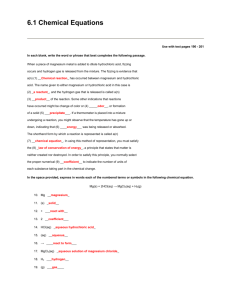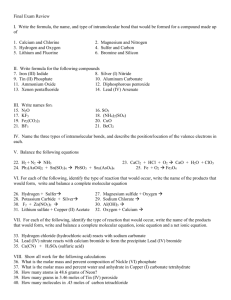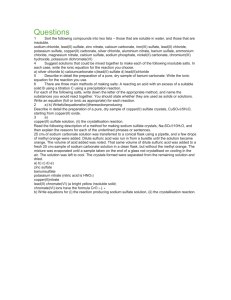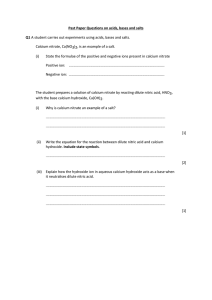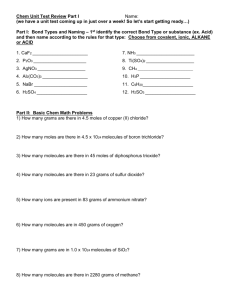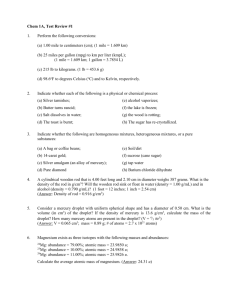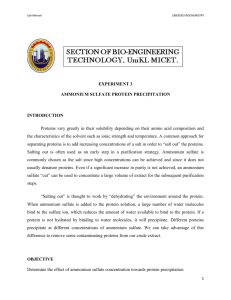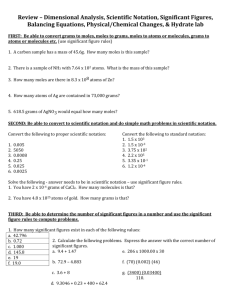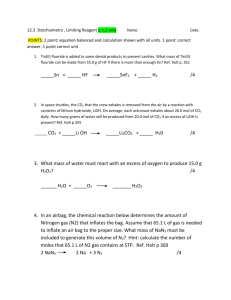Summer Assignment
advertisement
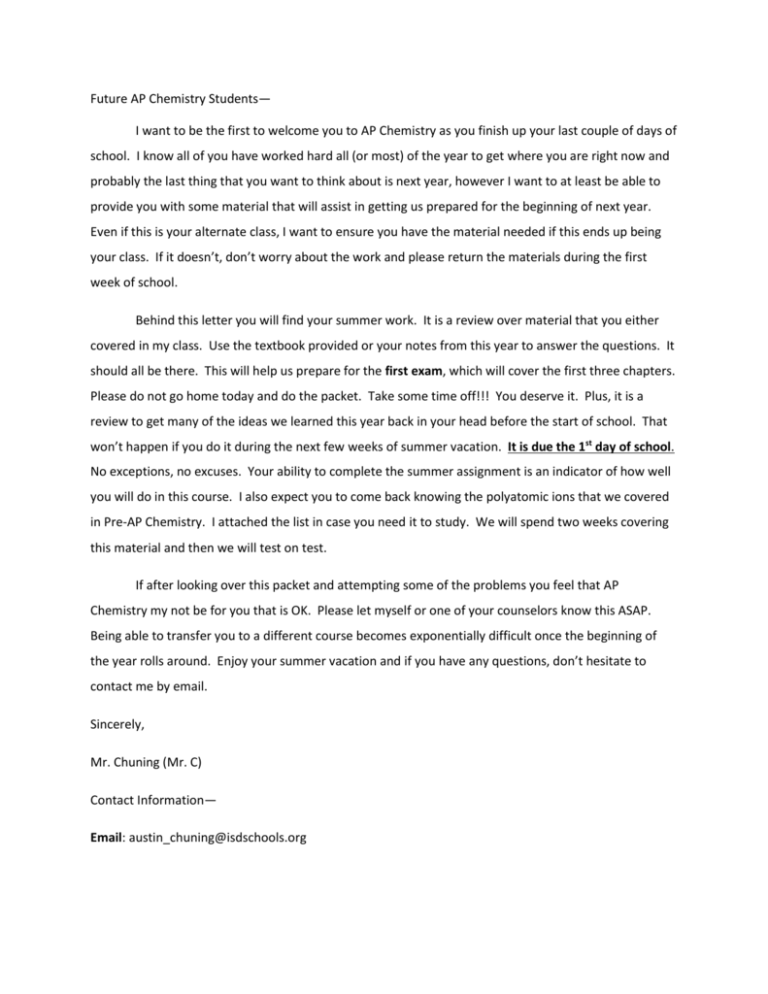
Future AP Chemistry Students— I want to be the first to welcome you to AP Chemistry as you finish up your last couple of days of school. I know all of you have worked hard all (or most) of the year to get where you are right now and probably the last thing that you want to think about is next year, however I want to at least be able to provide you with some material that will assist in getting us prepared for the beginning of next year. Even if this is your alternate class, I want to ensure you have the material needed if this ends up being your class. If it doesn’t, don’t worry about the work and please return the materials during the first week of school. Behind this letter you will find your summer work. It is a review over material that you either covered in my class. Use the textbook provided or your notes from this year to answer the questions. It should all be there. This will help us prepare for the first exam, which will cover the first three chapters. Please do not go home today and do the packet. Take some time off!!! You deserve it. Plus, it is a review to get many of the ideas we learned this year back in your head before the start of school. That won’t happen if you do it during the next few weeks of summer vacation. It is due the 1st day of school. No exceptions, no excuses. Your ability to complete the summer assignment is an indicator of how well you will do in this course. I also expect you to come back knowing the polyatomic ions that we covered in Pre-AP Chemistry. I attached the list in case you need it to study. We will spend two weeks covering this material and then we will test on test. If after looking over this packet and attempting some of the problems you feel that AP Chemistry my not be for you that is OK. Please let myself or one of your counselors know this ASAP. Being able to transfer you to a different course becomes exponentially difficult once the beginning of the year rolls around. Enjoy your summer vacation and if you have any questions, don’t hesitate to contact me by email. Sincerely, Mr. Chuning (Mr. C) Contact Information— Email: austin_chuning@isdschools.org AP Chemistry – Summer Review Assignment No, you don’t have to spend all summer studying chemistry. However, if you will spend a bit of time from time to time this summer reviewing the concepts and skills contained in this guide, you will be able to spend more time learning new material next year and your life (in chem) will be much easier. Plan on taking a test over this material during the first week of class; if there are concepts that we did not completely cover in class it is your responsibility to do research on YOUR OWN in order figure out how to come to an answer. Do not give up because you think you can’t. Find a solution! I know you can! I. Significant Figures and Basic Chemical Math 1. A piece of poster board measures 1.827 m long and 0.762 m wide. Find its area. Give the answer with the correct number of significant figures and proper units. 2. For a laboratory experiment, a teacher wants to divide all of a 453.6 g sample of sulfur equally among the 21 members of her class. How many grams of sulfur should each student receive? 3. Perform the indicated operations and give answers with the proper number of significant figures: a. 48.2 m + 3.82 m + 48.4394 m b. 148 g + 2.39 g + 0.0124 g c. 451 g – 15.46 g – 20.3 g d. 5.436 L + 5.3 L – 6.24 L – 0.177 L e. (51.5 m + 2.67 m) X (33.42 m -0.124 m) f. (125.1 g – 1.22 g) / (52.5 mL + 0.63 mL) 47.5 kg -1.44 kg g. h. 10.5 m X 0.35 m X 0.175m 0.307 g - 14.2 mg - 3.52 mg (1.22 cm - 0.28 mm) X 0.752 cm X 0.51 cm 4. Convert the following: a. 50 km to m b. 47.9 ML to L c. 578 ms to s d. 1.55 X 102 kg to milligrams e. 87.4 cm2 to mm2 f. 0.0962 km/min to m/s 5. Density a. The mass of 325 mL of liquid methanol is found to be 257 g. What is its density? b. A block of lead is 1.20 cm X 2.41 cm X 1.80 cm and has a mass of 59.01 g. What is the density of lead? c. What is the mass, in grams, of 30 mL of syrup that has a density of 1.32 g/mL? d. a square of aluminum foil (d= 2.70 g/cm3) is 5.10 cm on a side and has a mass of 1.762 g. Calculate the thickness of the foil, in millimeters. II. Atomic Structure 1. Complete the table: Symbol Atomic Number Atomic Mass # protons # neutrons # electrons 12 6 C 48 64 197 79 Na1 23 30 66 28 16 2. What are isotopes? 3. What are ions? How are they formed? 18 18 III. Nomenclature and Formulas 1. Ionic Compounds – formed from metal cations and nonmetal anions. a. Generally named as “metal name + nonmetal name → change ending to “ide” Example: CaCl2 = calcium chloride b. While charges are easy to obtain from the Periodic Table for main group elements (groups 1,2,3,4,5,6,7) remember that transition metals may have variable charge and the charge must be specified in the name. The charge can be determined from the number/charge of the anions attached. Example: CrCl3 – chromium (III) chloride. (It has to be chromium(III) because there are 3 chlorides in the compound and each chloride is -1 2. Polyatomic Ions – MEMORIZE! (Flash cards may be very helpful) ammonium NH4+ carbonate CO32- acetate C2H3O2- hydrogen carbonate (aka bicarbonate) HCO3- hypochlorite chlorite chlorate perchlorate ClOClO2ClO3ClO4- oxalate C2O42- sulfite SO32- cyonate thiocyanate OCNSCN- sulfate SO42- hydrogen sulfite HSO3- cyanide CN- hydrogen sulfate HSO4- hydroxide OHthiosulfate S2O32- phosphate PO43- nitrite nitrate NO2NO3- permanganate MnO4- hydrogen phosphate HPO42- chromate dichromate CrO42Cr2O72- dihydrogen phosphate H2PO4- You might want to develop your own mnemonics or strategies for internalizing formulas and charges. For example, if you know sulfuric acid is H2SO4, and you know that each hydrogen has a +1 charge, then the sulfate must be -2. Note, also, that all “family members” (for lack of a better term) have the same charge. If you know nitrate is -1, nitrite will also be -1. 1. Name them: NaCl Rb2O CaS AlI3 CrO Cr2O3 Al2O3 NaH CuBr2 ZnCl2 KClO4 Ca3(PO4)2 Al2(SO4)3 Pb(NO3)2 BaSO3 NaNO2 KMnO4 K2Cr2O7 (NH4)2CO3 LiOH b. Write them: cesium bromide barium sulfate ammonium chloride potassium nitrate sodium hydrogen carbonate calcium dihydrogen phosphate beryllium oxide magnesium fluoride iron(II) oxide iron(III) oxide lithium nitride ammonium acetate potassium chlorate cobalt(III) nitrate lead(IV) sulfide magnesium hydroxide copper(II) phosphate potassium dichromate sodium thoisulphate sodium hydrogen sulfite 3. Binary Molecular Compounds – formed from nonmetals a. First element is named as usual, second element is then named, changing the end to “ide” b. Greek prefixes are used to indicate the number of atoms present Example: N2O5 = dinitrogen pentoxide c. Name them: PCl5 PCl3 SF6 SO3 SO2 CO2 NI3 SF2 N2F4 P2S5 N2O CCl4 H2O d. Write them: carbon dioxide iodine pentachloride chlorine monoxide tetraphosphorus decoxide silicon tetraflouride disulfur dichloride oxygen diflouride carbon tetrabromide phosphorus trichloride (Note: your quiz over this material will contain “mixed” problems – ionic and molecular together) 4. Acids and Bases – Flash cards? Strong Acids HClO4 – perchloric HI – hydroiodic HBr – hydrobromic HCl – hydrochloric HNO3 – nitric H2SO4 - sulfuric Strong Bases group I hydroxides hydroxides from group II: Ca, Sr, Ba Weak Bases NH3 – ammonia and its organic derivatives Other acids (weak) HF – hydrofluoric H3PO4 – phosphoric **Note that the “ate” ion becomes the “ic” acid. HC2H3O2 or CH3CO2H – acetic H2CO3 – carbonic HCN – hydrocyanic H2S – hydrosulfuric HNO2 – nitrous H2SO3 – sulfurous H3PO3 – phosphorous HClO3 – chloric HClO2 – chlorous HClO – hypochlorous 5. Formulas for diatomic elements “Honkelbrif” – HONClBrIF all exist as diatomics “Mr. H. BrONClIF H2, O2, N2, Cl2, Br2, I2, F2 Also mercury (I) cation is a diatomic cation – Hg22+ IV. Basic Stoichiometry and Chemical Calculations 1. Balance: → Fe + O2 SiCl4 + H2O → PCl3 + H2O → CaO + P4O10 C2H6 + O2 H3PO4 + Ba(NO3)2 FeCl3 + SiO2 + HCl H3PO3 + → HCl Ca3(PO4)2 → NaCN + Fe2O3 CO2 → H2O HCN + Al2(SO4)3 NaOH + → → Na3PO4 BaSO4 + Fe(OH)3 + Al(NO3)3 NaCl 2. Molar Masses (use 2 decimal places with atomic masses) N2H4 C5H12 Li2O Mg(NO3)2 Ca(H2PO4)2 K2SbF5 sodium hydrogen sulfite ammonium perchlorate chromium(III) sulfate 3. Mole Conversions (1 mole = 6.02 X 1023 items) particles → moles → mass What is the mass of 0.250 mole of sodium? How many sodium atoms is this? How many moles of carbon dioxide are in 225g? How many molecules of water are in 4.68 mole water? How many sulfate ions are in 86.2 g of aluminum sulfate? How many molecules are in 37.0 mL of ethanol, C2H5OH, d = 0.789 g/mL? What is the mass of 1.75 X 1034 aluminum atoms? 4. Percent Composition a. Calculate the mass percent (percent by mass) of each element in ammonium nitrate, ammonium sulfate, and urea CO(NH2)2. On a kilogram per kilogram basis, which would be the best choice for fertilizer? b. How many grams of nitrogen are present in 46.34 g of ammonium nitrate? 5. Empirical and Molecular Formulas from Percent Composition. The process: Assume 100 g sample → percents become grams Convert to moles Write a “stupid-looking formula” with moles determined above as subscripts Get integers for subscripts by dividing all subscripts in your SLF by the smallest subscript If the subscripts are still non-integers, multiply all of them by the smallest number that will convert them to integers. This is the Empirical Formula. If finding the molecular formula, one more piece of data is needed – the molecular weight. Find the ratio between the molecular mass and the empirical formula mass – the integral value obtained is the multiplier factor the converts the subscripts of the EF to those of the MF. a. Cyclohexanol, used in the manufacture of plastics, has the mass percent composition: 71.95% carbon, 12.08% hydrogen and 15.97% oxygen. What is its empirical formula? b. TNT has the mass percent composition: 37.00% C, 2.20% H, 18.50% N, and 42.23% O, by mass. Find its empirical formula. c. The empirical formula of paradichlorobenzene, used as a moth repellant, is C3H2Cl. Its molecular mass is 147 u. What is its molecular formula? d. Resorcinol, used in the manufacture of resins, drugs and other products is 65.44% C, 5.49% H with the remainder being oxygen. Its molecular mass is 110 amu. What is its molecular formula? 6. Non-limiting reactant/non-solution Stoichiometry (consult your text for information on limiting reactant problems. Also consult youtube.com) a. The final step in the production of nitric acid involves the reaction of nitrogen dioxide with water. Another product is nitrogen monoxide. How many grams of nitric acid are produced for every 100.0 g of nitrogen dioxide that reacts? b. Upon being strongly heated or subjected to severe mechanical shock, ammonium nitrate decomposes into nitrogen and oxygen gases and water vapor. If 75.5 grams of ammonium nitrate decomposes, how many grams of each product is made? c. How many milliliters of liquid water should be produced by the combustion of 775 mL octane in abundant oxygen? Assume that the volumes of both liquids are measured at 20˚C, where the densities are 0.7025 g/mL for octane and 0.9982 g/mL for water. Skeleton: C8H18 (1) + O2 (g) → CO 2(g) + H2O(l) d. Lead(II) oxide reacts with ammonia, forming solid lead, nitrogen gas and liquid water. How many grams of ammonia are consumed in the reaction of 75.0 g lead(II) oxide? If 56.4 g of lead are produced, how many grams of nitrogen are also formed? e. Ordinary chalkboard chalk is solid mixture with limestone (calcium carbonate) and gypsum (calcium sulfate) as its principal ingredients. The limestone dissolves in dilute hydrochloric acid, producing calcium chloride, carbon dioxide and water. Gypsum does not react with HC1. If a 5.05 g piece of chalk that is 72.0% calcium carbonate is dissolved in excess HC1, what mass of carbon dioxide will be produced? Determine the mass percent of calcium carbonate in a 4.38 g piece of chalk that yields 1.31 g carbon dioxide when it reacts with excess HC1. Questions:
